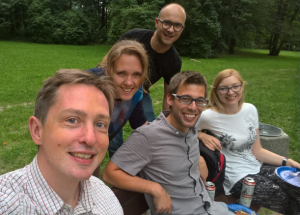
Communication between cells is an essential feature of living organisms. Signals received from the environment are processed and integrated by the cell, leading to changes in its morphology and behavior. Many human diseases, such as developmental defects and cancer, are caused by defective signal transduction.
Our laboratory studies various aspects of cellular signaling, with particular focus on the Hedgehog pathway. Hedgehog signaling is involved in the development of limbs, the spinal cord, the heart, and the brain. Its aberrant activation leads to many types of cancer, including the most common childhood brain tumor medulloblastoma. We want to find out how the signal is transmitted from the Hedgehog receptor Patched to Gli transcription factors, which are the main effectors of the pathway in the nucleus. To achieve that goal we use a variety of techniques, including mathematical modeling, genetic manipulation of mammalian cells, fluorescence imaging, qualitative and quantitative proteomics, transcriptomic analyses, mouse models of cancer, and in vivo manipulation of vertebrate embryos. This broad toolbox allows us to approach basic questions in molecular and cell biology from a variety of angles and to shed new light on fundamental mechanisms of signal transduction. We hope that our work will have implications for the treatment of human disease, including cancer.

phone: +48 22 55 43693
room: 3.43
Research Interests:
Paweł Niewiadomski’s long-term research goal is to understand how signaling pathways regulate transcription of genes in developmental processes and in disease. To this end, his research team is focusing on deciphering the mechanisms that determine transcriptional activity of Gli transcription factors, the main effectors of the Hedgehog signaling pathways. In addition to mechanistic biochemical studies, Paweł’s group also uses “big data” repositories and bioinformatic analyses to find novel promising targets for the treatment of drug-resistant cancers.
Current research projects:
Posttranslational modifications of Gli proteins
Gli transcription factors are large oncoproteins (>120kDa) that are heavily modified through phosphorylation, acetylation, ubiquitination, and others. These posttranslational modifications influence what compartments Gli proteins localize in, and affect their ability to activate or repress gene transcription. In cancer, the survival or rate of proliferation of tumor cells is determined by specific enzymatic modifications of Gli proteins. Therefore, enzymes that modify Gli proteins are an attractive target for cancer therapy. Our goal is to identify these enzymes using coimmunoprecipitation coupled with mass spectrometry, followed by RNAi- and CRISPR-based loss-of-function assays of Gli protein activity in vitro and in vivo.
Intracellular transport of Gli proteins
Gli proteins are targeted to specific cellular compartments, including the cell nucleus and the primary cilium. The inducible trafficking of Gli transcription factors to these organelles regulates their activity both in healthy development and in disease. Our goal is to elucidate mechanisms that drive Gli proteins into and out of cilia and nuclei with the hope to target these mechanisms in disease processes. To that end, we use molecular cloning, targeted mutagenesis, and microscopy coupled to semi-automated image analysis.
Novel therapy targets in cancer
The growth of each malignant tumor is typically driven by a handful of signaling pathways, which determine the proliferation and survival of cancer cells. However, these pathways are wired differently for different cancer types, and sometimes are not homogeneous even in different cells within the same tumor. Only by examining the molecular landscape of each cancer can we identify its “weak spots” that we can target therapeutically. We use the broadly available large datasets of genetic, epigenetic, and transcriptional changes in cancer cells and combine them with data from massive loss-of-function screens on cancer cell lines to devise new ways to kill malignant cells and overcome common mechanisms of antitumor drug resistance. These putative targets are then tested using a variety of experimental approaches – from cell line studies to in vivo experiments.
Positions held:
2015- Assistant professor/Group leader – Laboratory of Molecular and Cellular Signaling, Centre of New Technologies, University of Warsaw
2013-2015 Postdoc – Nencki Institute of Experimental Biology, Department of Cell Biology, Laboratory of Synaptogenesis
2013: Teaching/Research Associate – Medical University of Łódź, School of Medicine, Department of Molecular Cancerogenesis
2010-2012: Postdoc/Research Associate – laboratory of Rajat Rohatgi MD, PhD, Stanford University.
2005-2009: Postdoc – laboratory of James A. Waschek, PhD, David Geffen School of Medicine at UCLA
2005: Teaching/Research Assistant – Medical University of Łódź, School of Medicine, Department of Pharmacology
2003-2005: Teaching Assistant – University of Łódź, Department of Mathematics
2001-2004: Doctoral student – Medical University of Łódź in cooperation with the Department of Biogenic Amines (currently Center of Medical Biology), Polish Academy of Sciences
Education:
1996-2001: MSc in Pharmacy, School of Pharmacy, Medical University of Łódź, Poland
1999/2000: School of Pharmacy, Université Claude Bernard, Lyon, France – seven-month-long Erasmus/Socrates scholarship.
2001-2004: PhD in Pharmaceutical Sciences, Department of Pharmacodynamics, Medical University of Łódź, under the supervision of Prof. Jolanta B. Zawilska, PhD
1998-2003: MSc in Mathematics (specialty: Informatics), University of Łódź
Selected publications:
Coni S, Mancuso AB, Di Magno L, Sdruscia G, Manni S, Serrao SM, Rotili D, Spiombi E, Bufalieri F, Petroni M, Kusio-Kobialka M, De Smaele E, Ferretti E, Capalbo C, Mai A, Niewiadomski P, Screpanti I, Di Marcotullio L, Canettieri G. “Selective targeting of HDAC1/2 elicits anticancer effects through Gli1 acetylation in preclinical models of SHH Medulloblastoma.” Scientific Reports 7:44079 (2017)
Waschek JA, Cohen JR, Chi GC, Proszynski TJ, Niewiadomski P. “PACAP Promotes Matrix-Driven Adhesion of Cultured Adult Murine Neural Progenitors.” ASN Neuro. 9(3):1759091417708720 (2017)
Niewiadomski P*, Kong JH, Ahrends R, Ma Y, Humke EW, Khan S, Teruel MN, Novitch BG, Rohatgi R, “Gli protein activity is controlled by multisite phosphorylation in vertebrate hedgehog signaling.”, Cell Reports 6: 168-81 (2014).
* first and co-corresponding author
Niewiadomski P, Zhujiang A, Youssef M, Waschek JA, “Interaction of PACAP with Sonic hedgehog reveals complex regulation of the hedgehog pathway by PKA.”, Cellular Signaling, 25: 2222-30 (2013).
Lin Y, Niewiadomski P**, Lin B**, Nakamura H**, Phua SC, Jiao J, Levchenko A, Inoue T, Rohatgi R, Inoue T, “Chemically-inducible diffusion trap at primary cilia (C-IDTc) reveals molecular sieve-like barrier”, Nature Chemical Biology, 9: 437-43 (2013).
** equal contribution
Hirose M**, Niewiadomski P**, Tse G, Chi GC, Dong H, Lee A, Carpenter EM, Waschek JA., “Pituitary adenylyl cyclase-activating peptide counteracts hedgehog-dependent motor neuron production in mouse embryonic stem cell cultures.”, Journal of Neuroscience Research, 89: 1363-74 (2011).
** equal contribution
Kim WK, Meliton V, Park KW, Hong C, Tontonoz P, Niewiadomski P, Waschek JA, Tetradis S, Parhami F., “Negative regulation of Hedgehog signaling by liver X receptors.” Molecular Endocrinology, 23: 1532-43 (2009).
Lelievre V, Seksenyan A, Nobuta H, Yong WH, Chhith S, Niewiadomski P, Cohen JR, Dong H, Flores A, Liau LM, Kornblum HI, Scott MP, Waschek JA. “Disruption of the PACAP gene promotes medulloblastoma in ptc1 mutant mice.”, Developmental Biology, 313: 359-70 (2008).
Paweł Niewiadomski, PhD, DSc
PhD students:
Weronika Skarżyńska , MSc
Tomasz Uśpieński, MSc

| Title | Project Leader | Project period | Project funding |
|---|---|---|---|
| Mechanisms of protein transport to primary cilia | Paweł Niewiadomski | 2022 - 2026 | OPUS 22, NCN |
| The role of epigenetic modifications in Gli3R-dependent Hedgehog pathway repression | Weronika Skarżyńska | 2023 - 2025 | PRELUDIUM 21, NCN |
| Mechanisms of transcriptional repression by Gli proteins in Hedgehog signaling | Paweł Niewiadomski | 2020 - 2023 | OPUS 17, NCN |
| Role of heteromultimerization of MRCK kinases in physiological and pathological processes | Brygida Baran | 2020 - 2023 | PRELUDIUM 18, NCN |
| Role of the exocyst complex in transport of cytoplasmic proteins to the primary cilium | Sylwia Niedziółka | 2019 - 2022 | PRELUDIUM 15, NCN |
| Role of proteasome in the regulation of Gli protein activity by the Hedgehog pathway | Paweł Niewiadomski | 2018 - 2021 | OPUS 14, NCN |
| Role of primary cilia in the activation of Gli transcription factors in Hedgehog signaling | Paweł Niewiadomski | 2015 - 2020 | SONATA BIS 4, NCN |
Markiewicz, Ł., Uśpieński, T., Baran, B., Niedziółka, S. M., & Niewiadomski, P.
Cellular Signalling, 109907, 2021
Izzo M, Osella S*, Jacquet M, Kiliszek M, Harputlu E, Starkowska A, Łasica A, Unlu CG, Uśpieński T, Niewiadomski P, Bartosik D, Trzaskowski B, Ocakoglu K, Kargul J*
Biolectrochemistry, 140, 107818
Jacquet M, Kiliszek M, Osella S, Izzo M, Sar J, Harputlu E, Unlu CG, Trzaskowski B, Ocakoglu K, Kargul J*
RSC Adv., 11, 18860
Iliana Serifi, Simoni Besta, Zoe Karetsou, Panagiota Giardoglou, Dimitris Beis, Pawel Niewiadomski, Thomais Papamarcaki
Scientific Reports, 11(1), 1-13
Marcin Pęziński, Kamila Maliszewska-Olejniczak, Patrycja Daszczuk, Paula Mazurek, Paweł Niewiadomski, Maria Jolanta Rędowicz
International Journal of Molecular Sciences, 22(21), 12051
Bernadzki, K. M., Daszczuk, P., Rojek, K. O., Pęziński, M., Gawor, M., Pradhan, B. S., ... & Niewiadomski, P.
Frontiers in Molecular Neuroscience, 13, 104
Łastowska, M., Karkucińska-Więckowska, A., Waschek, J., & Niewiadomski, P.
Cells, 8(3), 216
Niewiadomski, P., Niedziółka, S. M., Markiewicz, Ł, Uśpieński, T., Baran, B., & Chojnowska, K.
Cells, 8(2), 147
Waschek, J. A., Cohen, J. R., Chi, G. C., Proszynski, T. J., & Niewiadomski, P. (2017).
ASN neuro, 9(3), 1759091417708720.
| Title | Deadline for applications |
|---|---|
| PhD Student (CeNT-44-2023) | 30/07/2023 |
| PhD student (CeNT-10-2023) | 20/03/2023 |
| PhD student (CeNT-1-2023) | 24/01/2023 |
| Postdoc (Adiunct)(CeNT-43-2022) | 25/11/2022 |
| PhD student (CeNT-42-2022) | 31/08/2022 |
| PhD Student in Laboratory of Molecular and Cellular Signaling | 01/08/2021 |
| Postdoc (Adjunct) in the Laboratory of Molecular and Cellular Signaling | 15/11/2020 |
| PhD Student in the Laboratory of Molecular and Cellular Signaling | 20/09/2020 |
| Postdoc in the Laboratory of Molecular and Cellular Signaling | 15/04/2020 |
| PhD Student in the Laboratory of Molecular and Cellular Signaling | 01/03/2020 |
| Post-doc in cell and molecular biology | 18/09/2019 |
| Postdoc in Molecular and Cell Biology | 31/07/2019 |
| Postdoc in cell and molecular biology | 25/05/2019 |
| Postdoctoral fellow in the Laboratory of Molecular and Cellular Signaling | 31/07/2018 |
| Research Assistant in the Laboratory of Molecular and Cellular Signaling | 31/07/2018 |


